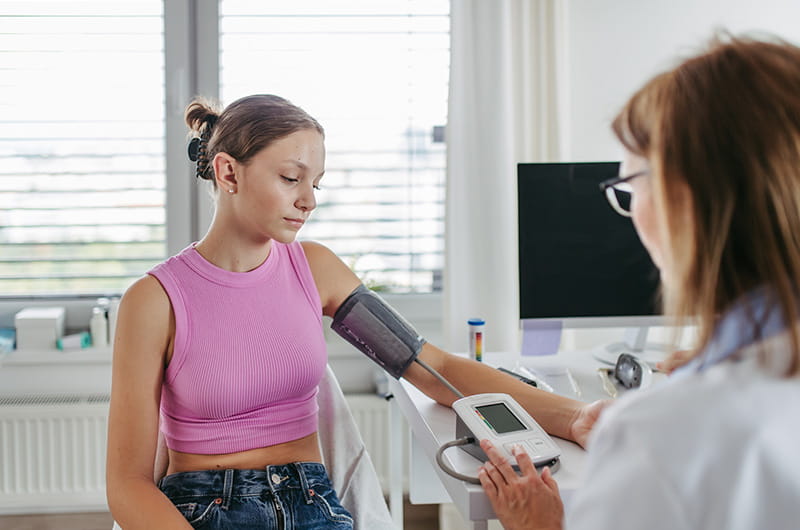Nearly 1 in 4 young U.S. adults have high blood pressure, but increasing social services could help

Nearly half of adults in the U.S. have high blood pressure, which over time can lead to damaged arteries and plaque buildup that causes heart attacks, strokes and other health problems. Past studies have found links between high blood pressure in childhood and cardiovascular disease as an adult.
According to two preliminary research abstracts presented at the American Heart Association’s 2024 Hypertension Scientific Sessions, nearly a quarter of young Americans (18-39) already have high blood pressure before age 40, and about 1 in 7 adolescents may have higher than normal blood pressure.
Researchers also found that young adults and adolescents with unmet social needs, such as food insecurity or low incomes, were much more likely to have untreated high blood pressure.
Both studies suggest that increasing social services could help prevent high blood pressure that can lead to cardiovascular problems later in life.
“Young adults with social needs and high blood pressure need more support to achieve blood pressure goals. Our study highlights that addressing these social drivers through targeted public health strategies is essential to improve outcomes and prevent long-term heart disease and stroke complications in this vulnerable population,” said one study author, Thomas Alexander, who is studying medicine at Northwestern University’s Feinberg School of Medicine in Chicago.
In Alexander’s study, a key finding was that nearly 23% of the young adults (18-39) had high blood pressure and were more likely to be uninsured, food insecure and have low incomes compared to older adults.
Adults with high blood pressure and two or more social needs were also about 80% more likely than adults with no social needs to be untreated and were about 70% more likely to have high blood pressure that was uncontrolled.
Study authors relied on data from the National Health and Nutritional Examination Survey (NHANES) collected during nutritional health surveys from 2017 to 2020. The data represented a cross-sectional sample of adults and children representative of the U.S. population. The study included health information collected from adults ages 18 years and older with data for blood pressure, use of high blood pressure medications, income, access to health insurance, employment status, education level and food security, or whether they had had trouble getting enough to eat in the previous year.
Using a cross-section of adults representative of the U.S. population, the survey assessed the nation’s health and nutritional status through interviews and physical exams. Besides gathering blood pressure data, it also included questions about the use of hypertension medications, income, access to health insurance, employment status, education level and food security, or whether they had had trouble getting enough to eat in the previous year.
The study did not establish a cause-effect relationship between difficult social circumstances and high blood pressure, but the authors said the data shows an association between the two.
The second study also used the NHANES from 2017 to 2020. Researchers analyzed health data for 2,600 youth, looking at the prevalence of elevated and high blood pressure by age groups, sex, race and ethnicity and weight status. It found that among children 8 to 19 years old, about 14% had elevated or high blood pressure.
Elevated blood pressure rates also increased with age: 3.3% of participants in the 8-12-year age group had elevated blood pressure, and 16.7% of participants in the 18-19-year age group had elevated blood pressure.
Though the data did not involve younger children, the American Academy of Pediatrics recommends annual blood pressure screenings beginning at age 3 and during every health care visit if they have other health issues such as obesity, diabetes, certain congenital heart defects or are taking medications known to increase blood pressure.
“Youth who have high blood pressure are more likely to have high blood pressure as adults, putting them at greater risk for heart disease and stroke,” said study author Ahlia Sekkarie, Ph.D., an epidemiologist in the Division for Heart Disease and Stroke Prevention at the Centers for Disease Control and Prevention in Atlanta. “A healthy diet and regular exercise are important to reducing the risk of high blood pressure. Ensuring that youth are eating a healthy diet and getting enough physical activity is crucial to helping prevent heart disease and stroke.”
It’s important not only to work to prevent high blood pressure in youth, said Bonita Falkner, a professor of medicine and pediatrics at Thomas Jefferson University in Philadelphia, but it’s also crucial to improve clinical strategies to recognize and manage abnormal blood pressure in this age group.
“The prevalence of high blood pressure in youth ages 8 to 19 years is not trivial. These data indicate that approximately 5% of adolescents enter adulthood with high blood pressure, a significant risk for premature cardiovascular events,” Falkner said. “Preventive interventions to reduce the risk of high blood pressure in youth are needed, as well as improved clinical strategies to recognize and manage abnormal blood pressure in youth.”
Falkner said policies that improve access to health care, healthy food and employment could not only reduce cardiovascular disease risk for young adults but also that of their children.





